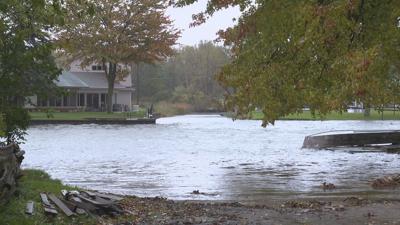BANGOR TOWNSHIP, Mich. (WJRT) - Great Lakes water levels have fallen since record high values were set last year but under the right weather conditions, shoreline flooding is still a threat.
Data from the U.S. Army Corps of Engineers shows that lakes Michigan, Huron, and Superior have fallen more than a foot since this time last year. Lakes Michigan and Huron (considered one body of water) are down 14 inches compared to October 2020 but still remain 17 inches above its long-term average.
The higher water levels seen in 2019 and 2020 led to erosion and flooding along many parts of the Great Lakes’ shoreline. It prompted several road projects to get underway after high water eroded away some of the land near roads. One of these projects was in Sanilac County on a stretch of M-25 in early 2020.
Along Saginaw Bay, the higher levels the last few years has led to several flood events but as water levels fell, residents living in these areas thought they might avoid another big event.
That changed in September when a strong area of low pressure moved into the Great Lakes region bringing strong winds off of the Saginaw Bay and it caused significant flooding in an area like Bangor Township. This storm led to flooding at Brandy Booth’s home along the Kawkawlin River.
“It came up four and a half feet last time. I measured it on my dock in a matter of three hours,” he said.
Booth said the water came up to his house and led to some damage.
That flood event came after strong northeast winds pushed water from Saginaw Bay into the river. It led water to rise that also flooded Glenn Rowley’s basement in his home along the river. Rowley is also the Bangor Township supervisor.
“It’s never good to make the news,” he said. “No matter what I did, the water did come up over the seawall - it came up to the house. Sandbags wouldn’t do anything because it was truly my sump pumps could not keep up.”
That storm was much stronger than the one moving through the region this week. The National Weather Service warned of possible lakeshore flooding with an advisory issued on Sunday for areas along the Saginaw Bay and Lake Huron Monday into early Tuesday. Wind gusts of up to 45 mph were possible.
Booth said he was hopeful that this storm was not going to cause any more issues and as of early Monday afternoon, it hadn’t.
“I think it’s going to be a little bit lower but you know, they could it could prove me wrong. Mother Nature does that,” Booth said.
Water levels are expected to continue their seasonal decline in the weeks to come. The Army Corps expects the lakes to fall between 2 and 6 inches during the next month.
For those that live near the water, Rowley said it’s always best to be prepared for any storm.
“After a while, you get tired of it but it’s not the time to be tired and do nothing,” he said.
Bangor Township residents have access to free sandbags that were donated by a number of partners. Rowley said several local organizations and individuals donated money to purchase the sandbags. This year, the township was able to get a sponsor, MDL, to provide the sandbags.
Latest data from the U.S. Army Corps of Engineers can be found here.
Copyright 2021 WJRT. All rights reserved.














